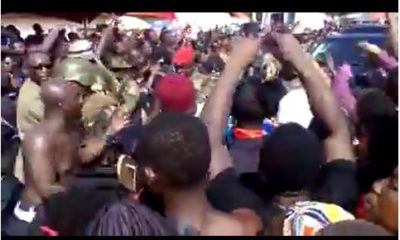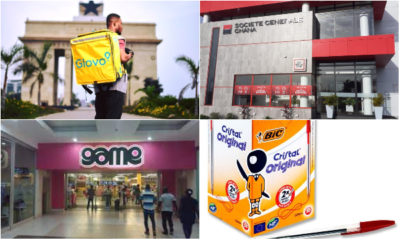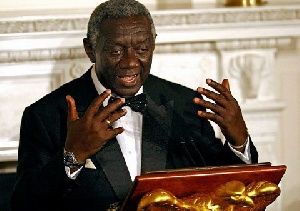Finance
Ghana’s crude oil production falls for 3rd consecutive year – PIAC report

It reported that a volume of 71,439,585 barrels was produced in 2019, but declined to 66,926,806 barrels in 2020, representing 6.32 per cent.
It further declined to 55,050,391 barrels in 2021 (17.75%) and then to 51,756,481 barrels in 2022 (5.98%).
The average decline over the three-year period stood at 10 per cent, the report observed.
Read the executive summary below:
Key Findings/Observations
Petroleum Production and Sales
1. Crude oil production has been declining for three consecutive years. A volume of 71,439,585 barrels was produced in 2019, but declined to 66,926,806 barrels in 2020, representing 6.32 percent. It further declined to 55,050,391 barrels in 2021 (17.75%) and then to 51,756,481 barrels in 2022 (5.98%). The average decline over the three-year period stood at 10 percent.
Recommendation
• There is the need for Ghana to speed up the sustainable development of its petroleum resources to reverse the decline in petroleum production through the attraction of new investors as well as early completion of ongoing projects.
Revenue Collection and Management
2. Total petroleum revenue in 2022 is the highest for a single year since inception of petroleum production in Ghana with a figure of US$1.43 billion.
3. Surface Rental Arrears continue to rise. It increased from US$2.58 million in 2021 to US$2.77 million in 2022, 65 percent (US$1.80 million) of which is owed by four (4) contractors whose Petroleum Agreements were terminated in 2021. Efforts made by the Ghana Revenue Authority to retrieve the arrears are yet to yield the desired results.
Recommendation
• GRA needs to intensify its efforts in the collection of Surface Rental arrears, particularly the amount owed by the four (4) contractors whose Petroleum Agreements were terminated in 2021.
Utilisation of ABFA
4. For two consecutive years (2021 – 1.74% and 2022 – 2.39%), the Ministry of Finance has not been able to meet the requirement to transfer five (5) percent of the ABFA to the District Assembly Common Fund, contrary to the decision of the Supreme Court of Ghana in the case of Kpodo and Another vs Attorney-General in 2019.
Recommendation
• In the disbursement of funds to the DACF, the Minister for Finance should comply with the decision of the Supreme Court of Ghana in the case of Kpodo and Another vs Attorney-General in 2019.
5. The Industrialisation Priority Area received an amount of GH¢9.29 million representing 0.20 percent of the total ABFA (GH¢4.41 billion). The disbursement which represents 4.29 percent of the amount budgeted (GH¢216.3 million) for the priority area for 2022 does not reflect giving priority to Industrialisation in the use of ABFA.
Recommendation
• Having rightly selected Industrialisation as a Priority Area, the government should show more commitment by investing more in industrial development.
6. An amount of GH¢643.61 million (US$73.68 million) was transferred to GIIF in 2022. According to the Fund, the entire disbursement was used to support the Agenda 111 Project of the Government. This is the second year after 2021 that GIIF has received funds for the Agenda 111 Project. In 2021 an amount of GH¢290.38 million (US$49.39 million) was allocated to the Fund.
Recommendation
• PIAC reiterates that Government should direct disbursements to GIIF intended for Agenda 111, to the Ministry of Health under the health component of the Education and Health Priority Area to support the Agenda 111 Project. Additionally, GIIF should focus the utilisation of its share of ABFA on its core mandate of investing funds in commercial infrastructural projects, in accordance with the GIIF Act, 2014 (Act 877) and policy guidelines of the Fund.
Management and Performance of Ghana Petroleum Funds
7. Even though US$508,656,349.80 was withdrawn from the GSF, the balance of the GPFs increased by 9.31 percent, from US$971.43 million as at the end of 2021 to US$1,061.89 million for the reporting period.
8. The retention of the current cap of US$100 million on the GSF for the year 2022 is not in accordance with the formula stipulated in L.I 2381. A proper application of the formula would have returned a cap of US$638.87 million. The current cap does not help build the Fund to serve its purpose.
Recommendation
• The Minister for Finance should comply with the relevant provisions of L.I 2381 in determining the cap on the GSF, in order that the Fund would be able to cushion the economy in times of unanticipated petroleum revenue shortfalls.
GNPC Allocation and Utilisation
9. GNPC’s expenditure on various line items, mainly administrative expenditure and GNPC’s capital projects, witnessed significant increases by more than 200 percent.
Recommendation
• Given that petroleum revenues recorded a historic high in 2022, PIAC recommends that GNPC should manage its expenditure and build buffers against volatilities in petroleum revenue inflows in the future.
10. In 2022, GNPC received an amount of US$38,835,537.56 as gas commodity revenue from the Cash Waterfall Mechanism (CWM) which constitutes petroleum revenue. This amount was not paid into the PHF.
11. GNPC continues to fund the construction of roads in the Western Corridor Enclave. This constitutes quasi-fiscal expenditure, and should be the primary responsibility of central government and not the NOC. The total expenditure by GNPC on these roads since 2014 is US$124.66 million.
Recommendation
• PIAC reiterates its call on GNPC to focus on its core mandate and for the government to desist from borrowing or requesting GNPC to make advances and guarantees on behalf of government and its agencies.
12. GNPC is using JOHL to carry out operations not approved in GNPC’s Workplan for 2022. Two notable examples are Explorco cash calls on Springfield, ENI Block 4 etc. – US$5,546,419.12 and SOPCL Decommissioning – US$11,000,000.00.
13. Total lifting proceeds received by JOHL (a subsidiary of GNPC) for 2022 amounted to US$272,652,208.95. Despite calls by PIAC that revenues of JOHL constitute petroleum revenue and should be paid into the PHF, GNPC disagrees and continues to use lifting proceeds of JOHL for other expenditures.
Recommendation
• Crude oil receipts by JOHL should be paid into the PHF since it forms part of Ghana’s petroleum revenue.
14. Total expenditure on the Saltpond decommissioning amounted to US$26.64 million in 2022. This is US$3.23 million more than the US$23.41 million approved in the 2022 Workplan of GNPC.
Operations of the GNGC
15. Although GNGC generates some revenue from the sale of processed gas, it has been unable to settle its indebtedness to GNPC for raw gas supplied because of the zeroed policy introduced by government to subsidise its portion of the CAPI of the gas. Apart from the payment of gas revenue in 2015 by GNPC, there has been no further gas payments into the PHF.
PIAC Project Inspections
16. During the period under review, the Committee inspected 29 ABFA-funded projects in seven (7) regions. For twenty-six (26) out of the projects visited, the ABFA component constituted an average of 57.31 percent of the project contract sum. The contract sum of the remaining three (3) projects was not available to the Committee at the time of the inspection.
The only project that was completed at the time of PIAC’s visit was fully funded with the ABFA.
Source: classfmonline.com
-

 Lifestyle1 month ago
Lifestyle1 month agoRoad Safety Authority narrates how buttocks causes road accident
-

 GENERAL NEWS2 months ago
GENERAL NEWS2 months agoWhy 15 police officers stormed Owusu Bempah’s church – Kumchacha narrates
-

 GENERAL NEWS1 month ago
GENERAL NEWS1 month agoWatch how Ibrahim Mahama rode Honda superbike to pay last respects to late friend
-

 GENERAL NEWS2 months ago
GENERAL NEWS2 months agoHow Offinso residents storm destooled queen mother’s house, demand for new chief
-

 South Africa News2 months ago
South Africa News2 months agoWoman thrown out of a speeding taxi while on her way to work
-

 GENERAL NEWS3 weeks ago
GENERAL NEWS3 weeks agoDeadly clash between youth and navy personnel results in two deaths at Tema Manhean
-

 SHOWBIZ KONKONSAH3 weeks ago
SHOWBIZ KONKONSAH3 weeks agoJunior Pope’s Death: Video of John Dumelo refusing to join canoe for movie shoot over safety concerns resurfaces
-

 News Africa2 months ago
News Africa2 months ago‘Satanically dubious’ – SCOAN releases statement on BBC’s report about TB Joshua, church
















